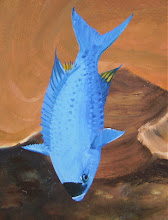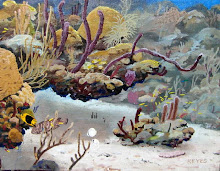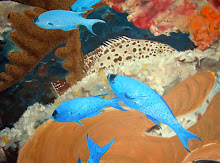Just some random photos today.
.
Ha, I was going to call this guy a plain brain, but the book says it's a Symmetrical Brain coral, Diploria strigosa. OK. Kind of a lot of silt around the bottom. Not a funny looking rock, a 'colony' of hundreds of tiny animals, on the surface of their skeleton laid down under their bodies. They are kind of like a living rug on the surface. Sometimes people say that polyps can hide down in their little holes, but that is not true.
.
Dee-ah-Demma. Or usually called Spiny Urchin. These spines can penetrate and sometimes cause humans problems when the human blunders into the poor little boogie and breaks his spines, causing injury and much dismay to all involved! Fire coral in the background, best to stay away from that stuff, too. But remember, these things cannot chase you.
.
.
These are called Sea Rods, I thimmk. Pretty.
.
.
Ah, and my favorite, a Sea Plume. I was once lucky to snorkel a little bay on the Venezuelan island Blanquilla. There were hundreds of these there, and they must have been fifteen feet tall! I've SO wished to go back there on a dive boat! Looking down from the surface is just not the same. This Sea Plume is about six feet, 2m, tall.
.
.
Blurry female Bluehead Wrasses, in front od a sponge. They swim so fast, difficult to get good focus.
.
.
Like many other fish, and some insects, these Wrasses are born all females. As they grow, they stay in loose schools, and after a while, the biggest one changes into a male. This is a teenage boy, I guess.
.
One insect that's born all female is the Aphid. In the spring, for the first fifteen generations! No wonder they take over your garden so quickly! Males are born in late summer for egg making.
.
Here, for sure, is the "Terminal" male Bluehead. They swim by sculling their pectoral fins, not flapping their tail or wriggling their whole body. They seem to be a little 'negatively bouyant', they sink, because they bob up and down slightly with each stroke. They really go fast. When this fish is eaten, or something happens to him anyway, one of the females will change sex and color to replace him.
.
.Ah, Thanks forstopping by!
.
Pixel 3XL DayZ Epoch Mod Image
3 years ago








.jpg)



.jpg)
.jpg)
.jpg)
.jpg)
.jpg)
.jpg)
.jpg)
.jpg)
.jpg)
.jpg)
.jpg)
Lots of interesting animals here, Melissa. I like the spiny urchin photo, the slideshows, and all. You've really been busy with your camera and blogging it all, too. Inspiring.
ReplyDelete